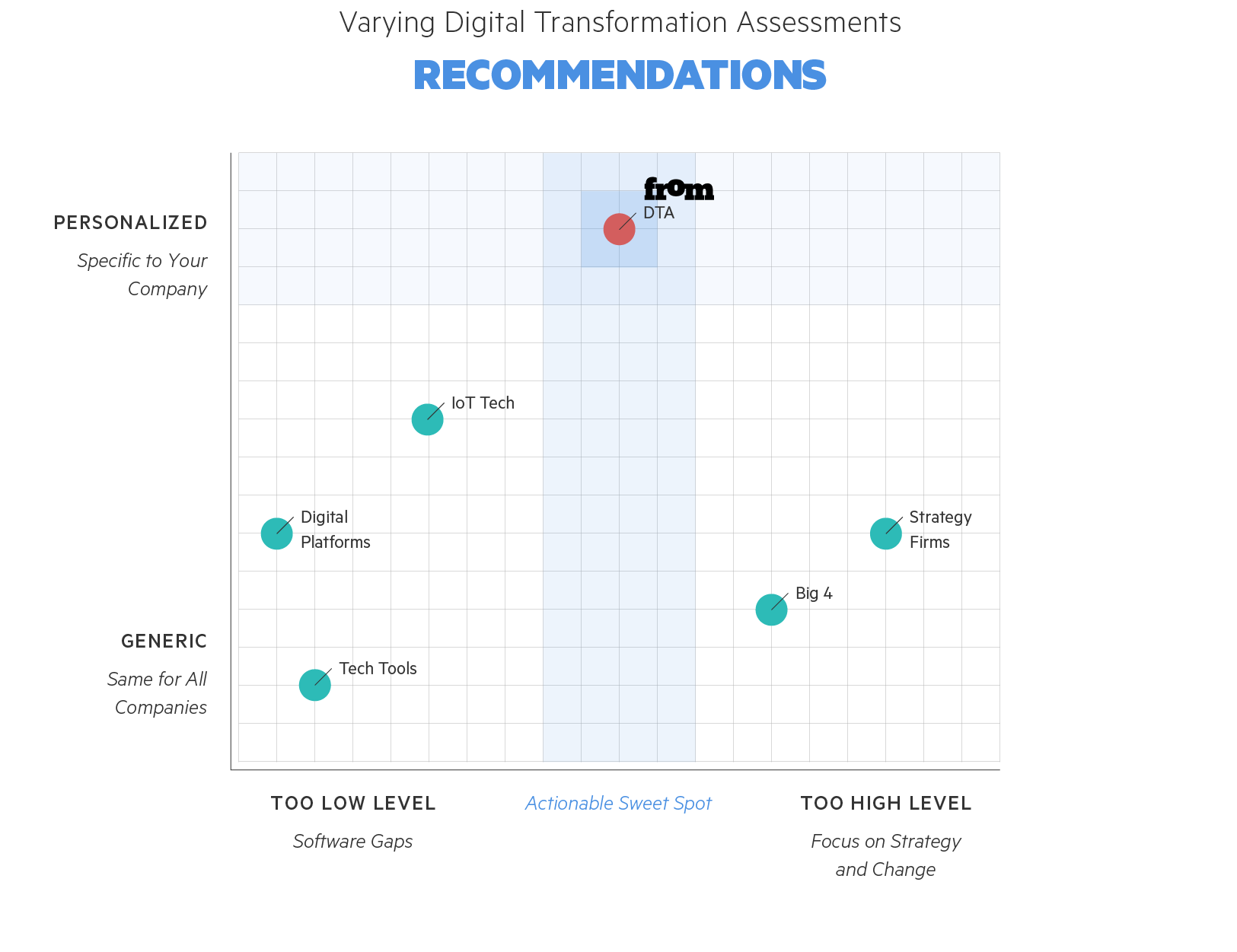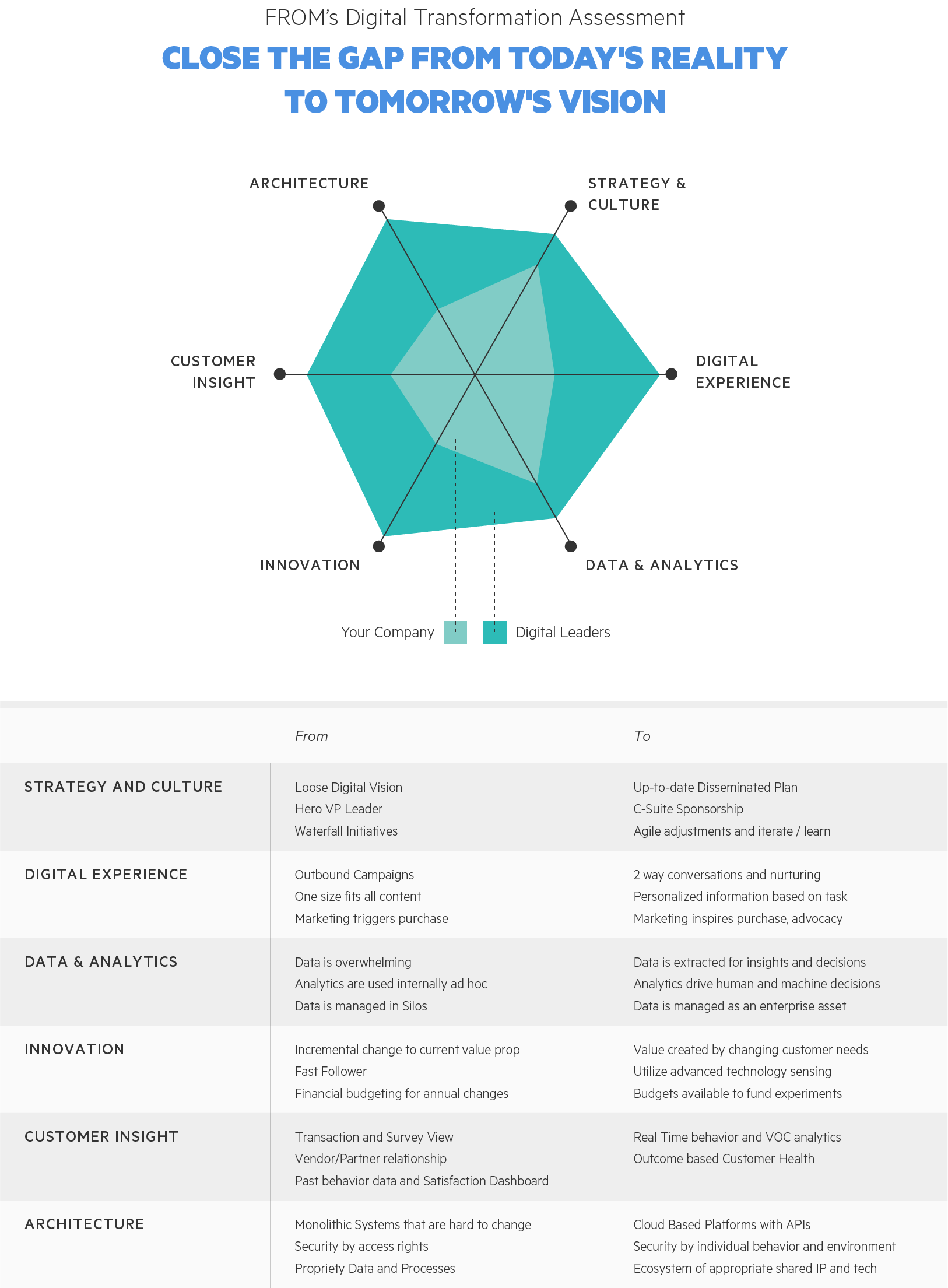Insights | By Bob Taylor
Find the next Best Digital Action for Your Business
If you are like most of our clients, your digital project list is overfull.
Even so, your company has decided that you need to deploy an app to better connect with your customers. Or it is reducing costs by giving customers greater self-service options, requiring a website overhaul. And as it snowballs, you've realized that it is a much bigger digital transformation project. In fact, Forbes just reported, "brands may find that they need to spend $4 on digital operational excellence for every $1 spent on digital customer experiences."1 But wait--it's even bigger: IDC estimates companies worldwide will spend $1.2T in 2017.2 (By the way, that probably means your competition is investing here too…)
This is big. And you have got to get it right. If you already know that optimizing the building blocks for digital success is important and therefore utilizing a digital assessment to help you learn, provide clarity for the digital transformation, and drive performance is a good next step, then read on. If not, then please read our article on why you may want to use a digital assessment by clicking here.
There is a dizzying array of assessments out there! In fact, last time we looked at Google, over 2.4 million search results were listed for “Digital Transformation Assessment.” That’s a lot of choices!
Some are trivial; others are strategic without offering operational insight. Others are myopic, focusing only on a function. Let's take a look at the types of assessments out there and what they offer. How do you choose the right one for you?
Consideration #1 - Level of Depth:
There are technology vendors who will assess capability within a business function (like digital marketing) at the feature/process level in order to highlight the gaps in your digital maturity that their software can close. These require a signup, although usually free (sometimes part of the selling process). They are fairly detailed and do a good job educating customers on what their software can do to increase a company’s maturity in a particular function that their software addresses.
There is also a myriad of Readiness Assessments, and Culture and Strategy Assessments at the enterprise level offered by a litany of consulting companies. These high-level assessments can be free or depend on the access to experts can turn out to be expensive. On the free end, there are a number of 15-minute rate yourself assessments that will give a flavor for what their perspective of “digital transformation” is by reading the best in class answers, but beyond that, they are not actionable and provide little value for any but the least mature companies. On the other end, one already expensive Big 4 Assessment solution has an optional track (for a fee) to meet with their experts in gap areas to get advice on how to fill the gaps at the functional level (Marketing, Sales, Service, Analytics, IT, etc.). These assessments focus on strategy, culture, and operations from the enterprise perspective, but their best practices are limited by their purview of their other clients at the functional level. All too often those recommendations are too generic to make an impact without additional customization by costly experts.
Consideration #2 - Recommendation Quality:

Besides depth of the digital assessment, there are a couple of other differences. One is the quality of the recommendations that are provided to close any gaps. Functional level or high-level assessments tend to provide general answers to digital strategy and culture. Low-level assessments, inform software modules that fill the self-identified feature/function need. In early stages, generic next steps that apply to nearly every company despite differences in industry, scale, customer base and business model are sometimes all that is needed to move the organization forward. However, in most cases, our clients are looking for more detailed and targeted insights to improve their customers’ digital experience.
A big criterion that affects the quality is observation vs. self-reporting. Self-reported ratings can be completed quickly and help identify alignment, responsibility and capability issues across the organization, but a “comments box” doesn’t allow for drill down. However, assessments that include direct observation provide much richer context. Dialog leads to drill down and cause analysis, which provides a better basis for actionable next steps. To identify and confirm the exact next best actions and the right priority and order requires that the dialogue goes far beyond self-reporting.

Consideration #3 - Impact on your Customer Experience:
Lastly, the most important assessment criteria are the maturity of the digital experience for your customers. What is the brand promise and how does that manifest itself in your digital properties? How are you meeting your customers’ needs today and treating them during the interactions? How is your experience meeting the needs of changing customer expectations? What will be the best action for highest impact for the customer? In many cases there are small changes that can provide early ROI, wins for the program and momentum! In other cases, their major missteps vs customers changing expectations. Also, by understanding the experience, any overall recommendations can be filtered to ensure there is not a negative impact on the customer experience (like self-service experiences which impact customer satisfaction scores). Any Digital Assessment which does not have a focus on the customer experience is a partial solution at best.
What is the Next Best Action for your business? We can help you use a digital transformation assessment to:
- Improve your business performance
- Improve your digital customer experience
- Increase the rate of organizational learning and change
- Benchmark capabilities to foster innovation, not imitation
- Identify areas that require strengthening
- 3rd Party Independent voice for change
- Enable the dialogue among executives to foster success of the digital initiatives